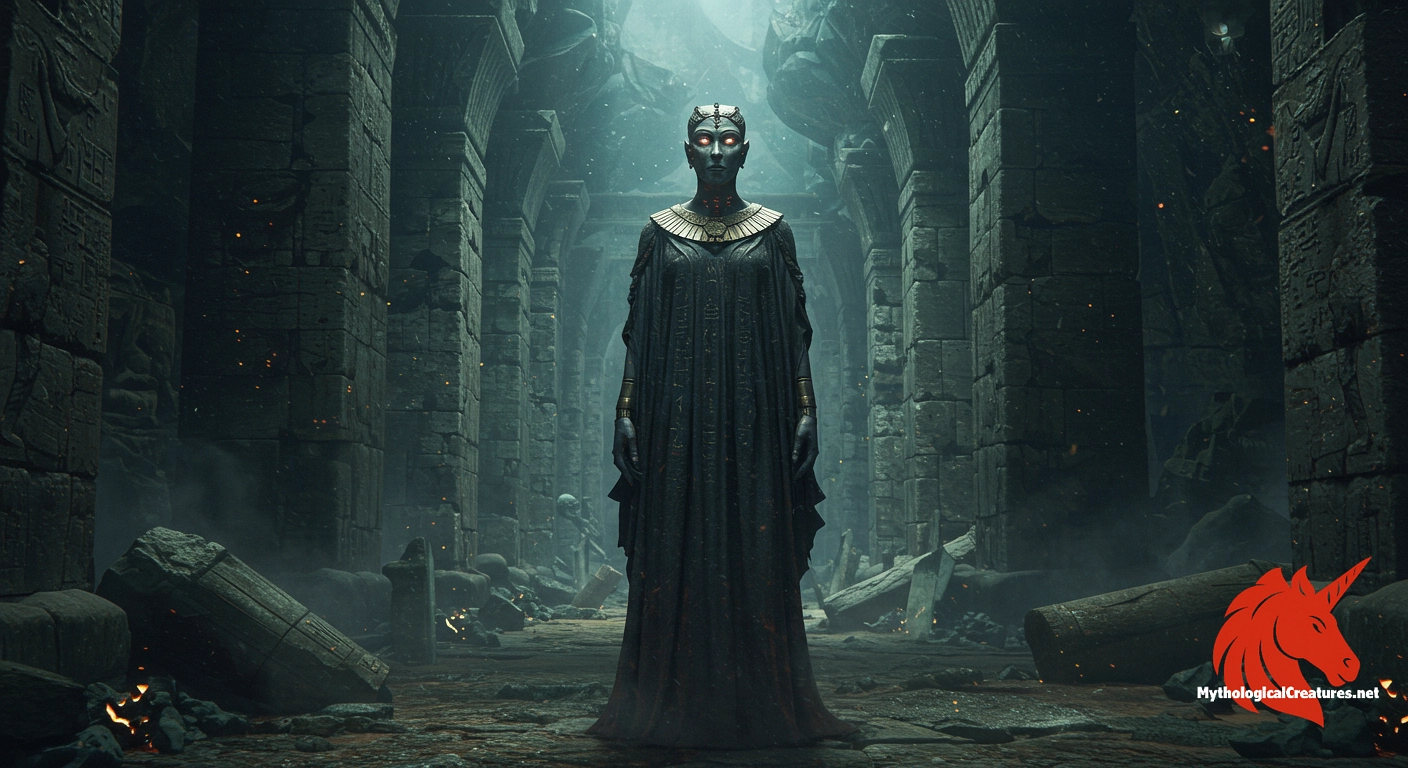Ereshkigal: Ereshkigal is the ancient Mesopotamian goddess ruling the underworld, known as Kur or Irkalla.

Ereshkigal
Ereshkigal - Ereshkigal is a central figure in Mesopotamian mythology, symbolising the inescapable nature of death and the necessary balance between life and the afterlife.
Origins & First Encounters
Ereshkigal emerges as a striking figure within the intricate tapestry of Mesopotamian mythology, revered as the sovereign of the underworld and a potent symbol of life’s inevitable transition. She is known by various epithets such as Irkalla and Ninkigal, each underscoring her formidable authority over the domain of the dead. Her earliest attestations are found in cuneiform texts which anchor her role in the ancient spiritual zeitgeist of Sumer. Serving as the central deity of Kur—the enigmatic underworld—she occupies a unique niche that balances themes of decay, power, and the unknown. Although her cult was relatively limited in scope, her impact on the religious landscape of Mesopotamia remained significant. Intriguingly, narratives also position her in a familial context, notably describing her as the elder sister in the tale of Inanna’s descent. This use of sibling terminology, while symbolic, hints at mutual recognition among the deities rather than literal kinship. The establishment of temple precincts, particularly in cities like Kutha, attests to her revered status. Over the centuries, her myth has continued to captivate both ancient worshippers and modern scholars, making her an enduring emblem of death and transformation.
Source Texts & Tale Variants
Ancient texts provide the fundamental basis for our understanding of Ereshkigal’s complex character. In the celebrated Sumerian narrative of Inanna’s Descent to the Underworld, she is portrayed with a grim dignity that underscores her dominion over death. Multiple textual traditions, preserved on clay tablets, reveal diverse story variants that sometimes emphasise her familial ties with other deities. These sources recount her mystifying marriage to Nergal, a union that highlights the interplay between life and death within the cosmos. Other narratives incorporate associations with gods like Ninazu and Ningishzida, thereby expanding her mythological repertoire. Fragmentary inscriptions from cities such as Kutha have enriched our knowledge, even though they sometimes present conflicting details. Oral traditions, subsequently committed to writing, added layers of complexity to her character and role in rituals. The multiplicity of these accounts illustrates the fluidity of myth in the ancient Near East. Through variations in storytelling and scriptural emphasis, early Mesopotamian communities offered a mosaic of interpretations that continue to stimulate scholarly debate. Collectively, these sources paint a portrait of a goddess who is as enigmatic as she is central to the ancient understanding of the afterlife.
Form & Powers
The iconography of Ereshkigal is as enigmatic and multifaceted as the myths that celebrate her. Artistic representations often evoke a sense of awe through her austere countenance, which mirrors the solemnity of the netherworld she rules. She is frequently depicted wearing a distinctive crown or formal headdress that symbolises her regal authority over the realm of shadows. Garments and adornments in these depictions are richly embellished with motifs that suggest decay and timeless mystery. The palette used in these artistic renderings typically features dark, muted tones, evoking an atmosphere of gloom and inevitability. Imagery of Ereshkigal sometimes incorporates elements such as stylised patterns or somber inscriptions that reinforce her connection to cosmic order. Although early texts leave her physical attributes largely to the imagination, later artistic traditions have imbued her with a visual narrative that balances both majesty and melancholy. Some artworks reveal an intense, penetrating gaze, as if inviting onlookers to peer into the secrets of the underworld. Through these visual traditions, her mysterious yet commanding presence is continually reinterpreted to reflect the layers of her mythic identity. Each portrayal, whether modest or elaborate, contributes to the spectral and enduring impression that Ereshkigal imparts.
Regional Faces
The myth of Ereshkigal exhibits a rich tapestry of regional variations that colour her character with local nuances. In the heartlands of Sumer, she is principally associated with the bleak and inescapable nature of the underworld, a reflection of local attitudes towards death and the afterlife. In other regions, such as in later Akkadian traditions, her persona is elaborated with added layers of complexity and even vulnerability. Regional adaptations often refer to her by alternative names like Irkalla or Ninkigal, each conveying subtle shifts in her symbolic essence. Local cultic practices in cities like Kutha highlight her close association with deities such as Nergal, reflecting the syncretic nature of Mesopotamian religion. Variations in myth across regions have allowed communities to tailor her narratives to fit local ritualistic and social needs. Some locales even depict her with more intimate, almost familial, characteristics, thereby softening the harsh inevitability of her dominion. The adjustments in religious iconography also indicate a dynamic interplay between central myths and peripheral local lore. This regional plurality serves as a testament to how ancient societies negotiated the abstract concept of mortality within varied cultural contexts. Ultimately, these differences enrich our understanding of Ereshkigal by showcasing the diversity inherent to ancient belief systems.
Cultural Parallels
The figure of Ereshkigal invites a compelling comparative analysis with underworld deities from diverse mythological traditions. Much like the Greek Hades, who both names the realm and its ruler, Ereshkigal embodies the dual concept of death as both a domain and an entity. However, her distinctly feminine aspect sets her apart, offering a counterpoint to the typically male-dominated depictions of death in many cultures. In some respects, she echoes the thematic duality found in the story of Persephone, albeit with a focus on the inevitability and finality of death rather than cyclical rebirth. Her narrative function also shares similarities with certain Egyptian deities that preside over mortality, highlighting universal human attempts to understand life beyond the earthly plane. The synthesis of her identity with that of the underworld itself mirrors a motif found in multiple ancient societies, where the ruler and the realm are seen as inseparable. Moreover, her complex relationships with other gods, such as her union with Nergal, reflect broader mythological themes of balance and transformation. These cross-cultural comparisons offer insight into how different communities have embodied the fears and mysteries surrounding death. In drawing such parallels, one can appreciate a shared mythological vocabulary that transcends temporal and geographic boundaries. Thus, Ereshkigal’s narrative contributes a uniquely Mesopotamian verse to the global chorus of underworld deities.
Legacy & Modern Evolution
The evolution of Ereshkigal’s mythological identity reflects a profound journey from ancient religious practice to enduring cultural symbol. Initially revered as the implacable ruler of the underworld, she gradually came to embody complex themes of mortality, destiny, and cosmic balance. Over time, her portrayal transitioned from a distant, fearsome goddess to a figure steeped in symbolic significance, mirroring changing attitudes towards death in evolving societies. As Mesopotamian cultural influences spread, fragments of her narrative were woven into later literary traditions, ensuring that her enigmatic presence was not forgotten. In contemporary times, reinterpretations of her character appear in literature, visual arts, and even digital media, where she is often portrayed as a brooding, multifaceted icon of death and renewal. Modern artistic renditions sometimes blend ancient symbolism with contemporary aesthetics, creating a dialogue between past and present. This enduring legacy speaks to the timeless human fascination with the mysteries of the underworld and the inevitability of death. The transformation in her depiction across millennia mirrors broader shifts in societal perceptions of mortality and existential purpose. As a result, Ereshkigal remains not simply a relic of ancient ritual but a dynamic muse for modern explorations into the nature of life and death. Her myth continues to inspire a reevaluation of ancient narratives, inviting new interpretations and reflections on the human condition.
Interesting Fact
One of the most intriguing aspects of Ereshkigal is her depiction as both a familial figure and a fearsome ruler, as seen in the complex relationships detailed in myths like Inanna's Descent.
Quick Creature Info
Origin:
Features:
Associations:
Our Mythic Legendary Rating:

Also Sometimes Known As:
Habitat:
Supernatural Powers:
Physical Attributes:
Abilities:
Behavior:
Lore:
References
Discover Another Mythical Legend You May Not Have Heard Of?
Uncover the mysteries of ancient folklore and expand your knowledge of legendary beings from cultures around the world.
Dare to Meet the Astomi....
Mythical Disclaimer: The images and data on this site are derived from various historical and literary sources, but we have found that many myths often have multiple versions and interpretations across references, sometimes contradictory. As a result, these creature depictions are artistic interpretations—imaginative blends of folklore, legend, and a dash of AI guesswork. Because creature descriptions vary widely, our illustrations and accompanying information represent our best effort to honor mythology while bridging creative gaps. Enjoy these interpretations—just remember, we've done our best to respect the stories and validate available data, but in the realm of mythology, details often shift, imagination leads the way, and nothing is ever set in stone!
Curated by the Mythological Creatures Team (rev. May 2025)
